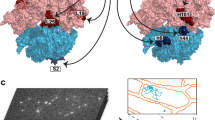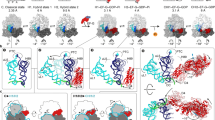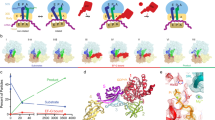Abstract
During translation elongation, ribosome translocation along an mRNA entails rotations of the ribosomal subunits, swiveling motions of the small subunit (SSU) head and stepwise movements of the tRNAs together with the mRNA. Here, we reconstructed the choreography of the collective motions of the Escherichia coli ribosome during translocation promoted by elongation factor EF-G, by recording the fluorescence signatures of nine different reporters placed on both ribosomal subunits, tRNA and mRNA. We captured an early forward swiveling of the SSU head taking place while the SSU body rotates in the opposite, clockwise direction. Backward swiveling of the SSU head starts upon tRNA translocation and continues until the post-translocation state is reached. This work places structures of translocation intermediates along a time axis and unravels principles of the motions of macromolecular machines.
This is a preview of subscription content, access via your institution
Access options
Subscribe to this journal
Receive 12 print issues and online access
$189.00 per year
only $15.75 per issue
Buy this article
- Purchase on Springer Link
- Instant access to full article PDF
Prices may be subject to local taxes which are calculated during checkout







Similar content being viewed by others
References
Moazed, D. & Noller, H.F. Intermediate states in the movement of transfer RNA in the ribosome. Nature 342, 142–148 (1989).
Ramrath, D.J. et al. Visualization of two transfer RNAs trapped in transit during elongation factor G-mediated translocation. Proc. Natl. Acad. Sci. USA 110, 20964–20969 (2013).
Zhou, J., Lancaster, L., Donohue, J.P. & Noller, H.F. How the ribosome hands the A-site tRNA to the P site during EF-G-catalyzed translocation. Science 345, 1188–1191 (2014).
Pulk, A. & Cate, J.H. Control of ribosomal subunit rotation by elongation factor G. Science 340, 1235970 (2013).
Tourigny, D.S., Fernández, I.S., Kelley, A.C. & Ramakrishnan, V. Elongation factor G bound to the ribosome in an intermediate state of translocation. Science 340, 1235490 (2013).
Zhou, J., Lancaster, L., Donohue, J.P. & Noller, H.F. Crystal structures of EF-G-ribosome complexes trapped in intermediate states of translocation. Science 340, 1236086 (2013).
Ratje, A.H. et al. Head swivel on the ribosome facilitates translocation by means of intra-subunit tRNA hybrid sites. Nature 468, 713–716 (2010).
Chen, C. et al. Single-molecule fluorescence measurements of ribosomal translocation dynamics. Mol. Cell 42, 367–377 (2011).
Adio, S. et al. Fluctuations between multiple EF-G-induced chimeric tRNA states during translocation on the ribosome. Nat. Commun. 6, 7442 (2015).
Schuwirth, B.S. et al. Structures of the bacterial ribosome at 3.5 A resolution. Science 310, 827–834 (2005).
Zhang, W., Dunkle, J.A. & Cate, J.H. Structures of the ribosome in intermediate states of ratcheting. Science 325, 1014–1017 (2009).
Agirrezabala, X. et al. Visualization of the hybrid state of tRNA binding promoted by spontaneous ratcheting of the ribosome. Mol. Cell 32, 190–197 (2008).
Frank, J. & Agrawal, R.K. A ratchet-like inter-subunit reorganization of the ribosome during translocation. Nature 406, 318–322 (2000).
Julián, P. et al. Structure of ratcheted ribosomes with tRNAs in hybrid states. Proc. Natl. Acad. Sci. USA 105, 16924–16927 (2008).
Holtkamp, W. et al. GTP hydrolysis by EF-G synchronizes tRNA movement on small and large ribosomal subunits. EMBO J. 33, 1073–1085 (2014).
Savelsbergh, A. et al. An elongation factor G-induced ribosome rearrangement precedes tRNA-mRNA translocation. Mol. Cell 11, 1517–1523 (2003).
Savelsbergh, A., Mohr, D., Kothe, U., Wintermeyer, W. & Rodnina, M.V. Control of phosphate release from elongation factor G by ribosomal protein L7/12. EMBO J. 24, 4316–4323 (2005).
Cunha, C.E. et al. Dual use of GTP hydrolysis by elongation factor G on the ribosome. Translation 1, e24315 (2013).
Rodnina, M.V., Savelsbergh, A., Katunin, V.I. & Wintermeyer, W. Hydrolysis of GTP by elongation factor G drives tRNA movement on the ribosome. Nature 385, 37–41 (1997).
Peske, F., Savelsbergh, A., Katunin, V.I., Rodnina, M.V. & Wintermeyer, W. Conformational changes of the small ribosomal subunit during elongation factor G-dependent tRNA-mRNA translocation. J. Mol. Biol. 343, 1183–1194 (2004).
Modolell, J. & Vázquez, D. The inhibition of ribosomal translocation by viomycin. Eur. J. Biochem. 81, 491–497 (1977).
Kuhle, B. & Ficner, R. A monovalent cation acts as structural and catalytic cofactor in translational GTPases. EMBO J. 33, 2547–2563 (2014).
Bock, L.V. et al. Energy barriers and driving forces in tRNA translocation through the ribosome. Nat. Struct. Mol. Biol. 20, 1390–1396 (2013).
Fischer, N., Konevega, A.L., Wintermeyer, W., Rodnina, M.V. & Stark, H. Ribosome dynamics and tRNA movement by time-resolved electron cryomicroscopy. Nature 466, 329–333 (2010).
Ermolenko, D.N. et al. Observation of intersubunit movement of the ribosome in solution using FRET. J. Mol. Biol. 370, 530–540 (2007).
Ermolenko, D.N. & Noller, H.F. mRNA translocation occurs during the second step of ribosomal intersubunit rotation. Nat. Struct. Mol. Biol. 18, 457–462 (2011).
Ermolenko, D.N. et al. The antibiotic viomycin traps the ribosome in an intermediate state of translocation. Nat. Struct. Mol. Biol. 14, 493–497 (2007).
Guo, Z. & Noller, H.F. Rotation of the head of the 30S ribosomal subunit during mRNA translocation. Proc. Natl. Acad. Sci. USA 109, 20391–20394 (2012).
Chen, J., Petrov, A., Tsai, A., O'Leary, S.E. & Puglisi, J.D. Coordinated conformational and compositional dynamics drive ribosome translocation. Nat. Struct. Mol. Biol. 20, 718–727 (2013).
Caliskan, N., Katunin, V.I., Belardinelli, R., Peske, F. & Rodnina, M.V. Programmed -1 frameshifting by kinetic partitioning during impeded translocation. Cell 157, 1619–1631 (2014).
Johnson, K.A. Fitting enzyme kinetic data with KinTek Global Kinetic Explorer. Methods Enzymol. 467, 601–626 (2009).
Katunin, V.I., Savelsbergh, A., Rodnina, M.V. & Wintermeyer, W. Coupling of GTP hydrolysis by elongation factor G to translocation and factor recycling on the ribosome. Biochemistry 41, 12806–12812 (2002).
Pan, D., Kirillov, S.V. & Cooperman, B.S. Kinetically competent intermediates in the translocation step of protein synthesis. Mol. Cell 25, 519–529 (2007).
Cornish, P.V., Ermolenko, D.N., Noller, H.F. & Ha, T. Spontaneous intersubunit rotation in single ribosomes. Mol. Cell 30, 578–588 (2008).
Munro, J.B., Wasserman, M.R., Altman, R.B., Wang, L. & Blanchard, S.C. Correlated conformational events in EF-G and the ribosome regulate translocation. Nat. Struct. Mol. Biol. 17, 1470–1477 (2010).
Robertson, J.M., Paulsen, H. & Wintermeyer, W. Pre-steady-state kinetics of ribosomal translocation. J. Mol. Biol. 192, 351–360 (1986).
Brilot, A.F., Korostelev, A.A., Ermolenko, D.N. & Grigorieff, N. Structure of the ribosome with elongation factor G trapped in the pretranslocation state. Proc. Natl. Acad. Sci. USA 110, 20994–20999 (2013).
Borg, A. & Ehrenberg, M. Determinants of the rate of mRNA translocation in bacterial protein synthesis. J. Mol. Biol. 427, 1835–1847 (2015).
Robertson, J.M. & Wintermeyer, W. Mechanism of ribosomal translocation. tRNA binds transiently to an exit site before leaving the ribosome during translocation. J. Mol. Biol. 196, 525–540 (1987).
Mohan, S., Donohue, J.P. & Noller, H.F. Molecular mechanics of 30S subunit head rotation. Proc. Natl. Acad. Sci. USA 111, 13325–13330 (2014).
Rodnina, M.V. & Wintermeyer, W. GTP consumption of elongation factor Tu during translation of heteropolymeric mRNAs. Proc. Natl. Acad. Sci. USA 92, 1945–1949 (1995).
Hickerson, R., Majumdar, Z.K., Baucom, A., Clegg, R.M. & Noller, H.F. Measurement of internal movements within the 30 S ribosomal subunit using Förster resonance energy transfer. J. Mol. Biol. 354, 459–472 (2005).
Lieberman, K.R. et al. The 23 S rRNA environment of ribosomal protein L9 in the 50 S ribosomal subunit. J. Mol. Biol. 297, 1129–1143 (2000).
Majumdar, Z.K., Hickerson, R., Noller, H.F. & Clegg, R.M. Measurements of internal distance changes of the 30S ribosome using FRET with multiple donor-acceptor pairs: quantitative spectroscopic methods. J. Mol. Biol. 351, 1123–1145 (2005).
Johnson, K.A., Simpson, Z.B. & Blom, T. FitSpace explorer: an algorithm to evaluate multidimensional parameter space in fitting kinetic data. Anal. Biochem. 387, 30–41 (2009).
Johnson, K.A., Simpson, Z.B. & Blom, T. Global kinetic explorer: a new computer program for dynamic simulation and fitting of kinetic data. Anal. Biochem. 387, 20–29 (2009).
Acknowledgements
We thank R. Green (Johns Hopkins University) and J. Maddock (University of Michigan) for the E. coli strains carrying ΔS13 and ΔL33 ribosomes, respectively, and A. Pfeifer, O. Geintzer, S. Kappler, C. Kothe, T. Uhlendorf, T. Wiles and M. Zimmermann for expert technical assistance. The work was supported by a grant from the Deutsche Forschungsgemeinschaft in the framework of Sonderforschungsbereich 860 (to M.V.R.). H.S. acknowledges support from a Boehringer Ingelheim Doctoral Fellowship.
Author information
Authors and Affiliations
Contributions
R.B., H.S., N.C. and C.E.C. performed experiments. R.B. and M.V.R. performed data analysis. R.B., H.S., N.C., C.E.C., F.P., W.W. and M.V.R. contributed to the design of the experiments and data interpretation. R.B. and M.V.R. wrote the paper with input from all authors.
Corresponding author
Ethics declarations
Competing interests
The authors declare no competing financial interests.
Integrated supplementary information
Supplementary Figure 1 Functional activity of fluorescence-labeled ribosome complexes used in this study, as determined by the time-resolved puromycin assay.
Closed circles, unlabeled PRE complex; open circles, S13-Alx; closed squares, S13-Q–L33-Alx; open squares, S6-Alx488–L9-Alx568, triangles, tRNA(Flu)–L33-Q. The full activity of the PRE L12-Alx–EF-G-QSY9 complexes was reported earlier30.
Supplementary Figure 2 Translocation as monitored by fluorescence changes of S13-Alx.
(a) Fluorescence changes of S13-Alx accompanying PRE and POST complex formation. Addition of the ternary complex EF-Tu–GTP–Phe-tRNAPhe (TC) to the initiation complex 70S–mRNA–fMet-tRNAfMet (IC) leads to the formation of the PRE complex (1→2, dark red); EF-G–GTP is added to the PRE complex, forming the POST complex (2 → 3 → 4, black); TC and EF-G–GTP together are added to IC (1 → 4, dark blue). (b) Linear dependence of kapp1 from the exponential fitting of time courses; slopes are 62 ± 10 µM−1s−1 (GTP) and 49 ± 2 µM−1s−1 (GTPγS). (c) In the presence of GTP the hyperbolic fit of kapp2 saturates at 22 ± 2 s−1 with an apparent KM of 0.4 ± 0.2 µM; the kapp3 value is 1 s−1 independent of EF-G concentration (data not shown). With GTPγS, kapp2 saturates at a rate of 0.43 ± 0.02 s−1 with an apparent KM of 0.2 ± 0.1 µM; kapp3 was not observed. The rate of GTPγS hydrolysis is about 0.005 s−1 at 37°C (ref. 9). Values are mean and s.e.m. of the fit (n = 8 technical replicates). In those cases where the error bars are not seen, the value is smaller than the symbol size.
Supplementary Figure 3 Controls for SSU head dynamics monitored by S13-L33 FRET.
(a) Ribosome intermediates describing the rotational movements of the SSU head during the transition from PRE to POST states10,23,24 (Schuwirth, B.S. et al. Nat. Struct. Mol. Biol. 13, 879-86 (2006); Borovinskaya, M.A. et al. Nat. Struct. Mol. Biol. 14, 727-32 (2007), Dunkle, J.A. et al. Science 332, 981-4 (2011)). Protein S13, magenta; L33, yellow. (b) FRET changes upon addition of the ternary complex EF-Tu–GTP–Phe-tRNAPhe (TC) to the initiation complex 70S–mRNA–fMet-tRNAfMet (IC) leads to the formation of the PRE complex (1→2, red); EF-G–GTP was added to the PRE complex, forming the POST complex (2 → 3 → 4, gray); TC and EF-G–GTP together are added to IC (1 → 4, light blue). (c) Translocation reactions were carried out with EF-G and double-labeled PRE complex (S13-Q–L33-Alx) or single-labeled PRE complex (L33-Alx) (donor only) in the presence or absence of GTP. PRE complexes were mixed with EF-G with or without GTP (Methods). (d) The hyperbolic fit of kapp1 saturates at 92 ± 7 s−1 with an apparent KM = 1.2 ± 0.3 µM. (e) The kapp2 value saturates at 8.1 ± 0.1 s−1, KM = 0.06 ± 0.02 µM. Values are mean and s.e.m. of the fit (n = 8 technical replicates); s.e.m. values are smaller than the symbol size. Anisotropy of the Alexa488 dye attached to L33 on the ribosome is 0.159 ± 0.002, which is sufficiently low to consider the ‹κ2› = 2/3 a valid approximation44.
Supplementary Figure 4 Controls for SSU-LSU rotation monitored by S6-L9 FRET.
(a) FRET change upon mixing EF-G–GTP with PRE complexes (S6-Alx488) and L9-Alx568) monitored in donor and acceptor channels. The decrease in donor fluorescence is attenuated by an increase in acceptor fluorescence, due to the use of a cut-off filter. (b) Fluorescence in donor and acceptor channels monitored with single-labeled S6-Alx488 ribosomes. (c) Fluorescence in donor and acceptor channels monitored with single-labeled L9-Alx568 ribosomes. Anisotropies of the Alexa488 on S6 and Alexa568 on L9 in single-labeled 70S ribosomes are 0.197 ± 0.003 and 0.292 ± 0.002, respectively. Despite the relatively high anisotropy of the acceptor dye, the FRET efficiency is not affected by the dye orientation25,44. Other spectroscopic properties of the FRET pair are described elsewhere25.
Supplementary Figure 5 Goodness of global fitting for a five-step reaction model.
Analysis of the confidence contour based on the search for SSE (Sum of Square Error) minima while varying one parameter (i.e. rate constant) at a time31. The sharpness of the minimum peaks denotes an optimal resolution of all rate constants describing the EF-G–dependent translocation in the presence of GTP (a) and GTPγS (b). Red dashed lines show the lower and upper boundaries as calculated for a χ2 threshold of 1.025 (refs. 31,45,46).
Supplementary Figure 6 Goodness of global fitting for four-step and six-step reaction models.
(a) For the four-step scheme, the lower limit for k–1 is undefined, the estimated k1 is much lower than estimated from the concentration dependence of k1 in Supplementary Fig. 2b, and a monomolecular step of about 100 s−1 corresponding to GTP hydrolysis 19,33 is not defined. Visual inspection indicates deviations of the fit to the four-step model from the experimental data (not shown), suggesting that global fitting to a four-step scheme does not provide a consistent fit.
(b) For the six-step scheme, the upper limits for k1 and k–1 are poorly defined; the rate of additional step 1a is about 300 s−1, which is not observed directly, but cannot be excluded. Regardless of the model, global analysis robustly finds three steps, with the global minima at about 33-43 s−1, 14-15 s−1, and 4 s−1, corresponding to steps 3, 4, and 5 of the five-step model; step 2 with the rate of 80-100 s−1 is well-defined in the five- and six-step models and consistent with the previous data. Red dashed lines show the lower and upper boundaries as calculated for a χ2 threshold of 1.025 for the four-step model (the calculated χ2 threshold of the fit is 1.0025) and 1.032 for the six-step model (the calculated χ2 threshold of the fit is 1.0032) (refs. 31,45,46).
Supplementary Figure 7 Comparison of the IFI values for the five-step and six-step models.
(a,b) Absolute IFI values for the S13-L33 (red) and S6-L9 (black) FRET pairs. (c,d) Normalized representation of the same data. Note that the trend for the IFI changes is independent of the model. The only difference is the presence of an additional, very rapid step (step 1a or k1a = 300 s−1) in the six-step model (Supplementary Fig. 6b), for which the global fit does not give a statistically significant solution. Average IFI values and error bars are averages with error bars representing standard deviations (s.d.) (n = 3 independent kinetic experiments); in comparison, the s.e.m. of the fit for each IFI is smaller than the symbol size (not shown).
Supplementary Figure 8 EF-G–catalyzed translocation with GTP and nonhydrolyzable GTP analogs.
(a) S13 fluorescence. The final fluorescence is very similar for GTPγS (blue) and GDPNP (green) and much higher when GTP (black) is used and hydrolyzed by EF-G, suggesting a different final conformation of the complex, probably due to the retention of EF-G. The overall shape of the time course obtained with GDPNP differs from that monitored with GTP. (b) S13-L33 FRET. The final level is similar for all three non-hydrolysable analogs and lower than after GTP hydrolysis. The apparent rates of the upward reaction range between 0.1 s−1 (GTPγS), 0.2 s−1 (GDPCP, pink) and 0.7 s−1 (GDPNP) compared to 8 s−1 (GTP, cf. Supplementary Fig. 3e). Note that in a and b the downward phase (reflecting steps 1 and 2, respectively) is kinetically similar with GTP and GTPγS (see also Fig. 6), but is not observed with GDPNP and GDPCP.
Supplementary information
Supplementary Text and Figures
Supplementary Figures 1–8 (PDF 1070 kb)
Rights and permissions
About this article
Cite this article
Belardinelli, R., Sharma, H., Caliskan, N. et al. Choreography of molecular movements during ribosome progression along mRNA. Nat Struct Mol Biol 23, 342–348 (2016). https://doi.org/10.1038/nsmb.3193
Received:
Accepted:
Published:
Issue Date:
DOI: https://doi.org/10.1038/nsmb.3193
This article is cited by
-
A model for ribosome translocation based on the alternated displacement of its subunits
European Biophysics Journal (2023)
-
Visualizing translation dynamics at atomic detail inside a bacterial cell
Nature (2022)
-
Altered tRNA dynamics during translocation on slippery mRNA as determinant of spontaneous ribosome frameshifting
Nature Communications (2022)
-
Accuracy mechanism of eukaryotic ribosome translocation
Nature (2021)
-
Structural basis for selective stalling of human ribosome nascent chain complexes by a drug-like molecule
Nature Structural & Molecular Biology (2019)



